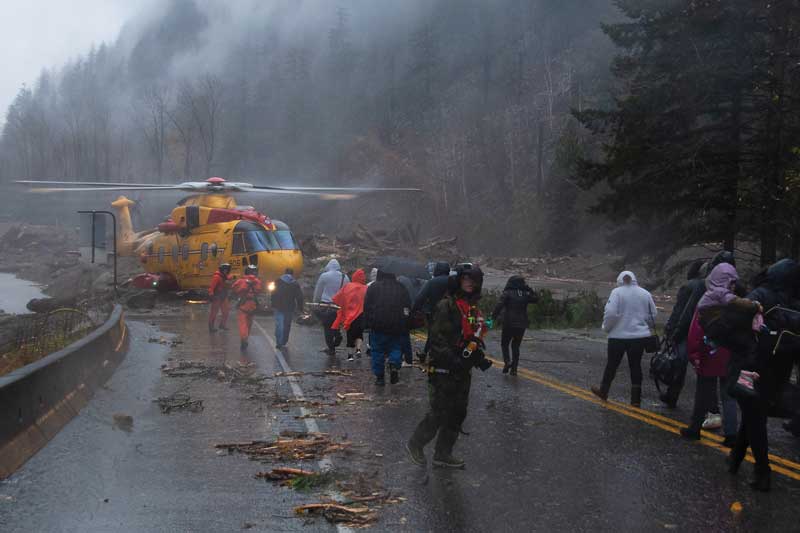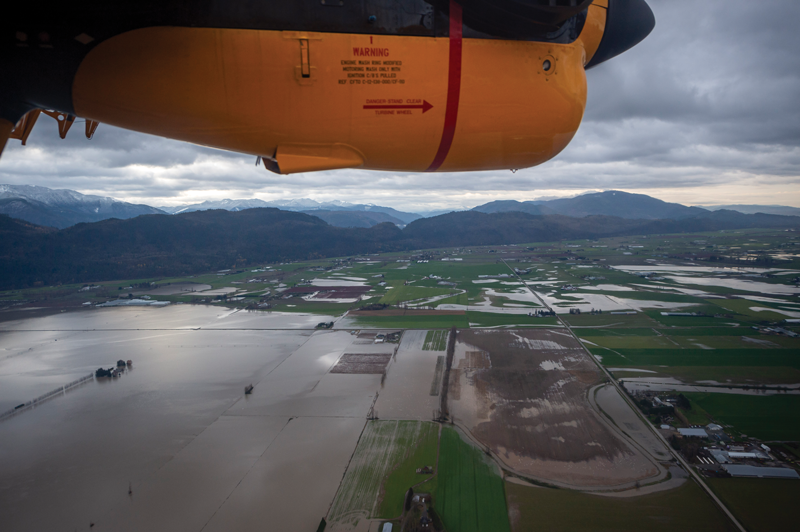
When domestic emergencies strike
—such as the November 2021 B.C. floods—the Canadian military often comes to the rescue
Over two days in November 2021, a “pineapple express” rolled through the Pacific Northwest, leaving in its wake a swath of devastation the likes of which had not been seen in living memory.
A reference to its oceanic origins northeast of Hawaii, pineapple express is a lyrical moniker for what meteor-ologists call an “atmospheric river,” or a corridor of concentrated moisture. It sounds less threatening than it is.
When it made landfall on Nov. 14, the storm commenced a chaotic run of devastation wrought by high winds and heavy rains—a once-in-500-year event that dealt British Columbia up to $9 billion in damages.
By the time the blitz was over, the storm had dumped nearly 30 centimetres of precipitation in some areas of the region. At least five British Columbians were dead. Thousands of others were trapped. Many more would be displaced. Homes and businesses were destroyed. Farms were wiped out; about a half-million farm animals killed.
All land links between the port of Vancouver and the rest of Canada—two railroads and two highways—were severed by mudslides and washouts. B.C.’s main north-south routes—highways 5 and 99—were also blocked.
Finding places to put a chopper down along the battered route was difficult.

The storm was in its last throes when Captain Jonathan Groten, a Cormorant pilot with 442 Transport and Rescue Squadron based in Comox, B.C., got word that several vehicles were trapped among mudslides near Agassiz, B.C. The cars were stuck on Highway 7, which runs along the north side of the Fraser River between Vancouver and Hope.
Otherwise short on details, the 13-year military veteran prepared to head out with his crew: co-pilot, Capt. Evan Southern; flight engineer, Corporal Jordan Pugh; and search-and-rescue (SaR) techs, Sergeant Ashley Barker and Master Corporal Nick Meade.
They weren’t sure what to expect, though experience did tell them to bring duffle bags for unco-operative pets. But how many people were trapped and what challenges the crew would face were unclear.
“We thought we’d get the job done with one helicopter,” Groten told Legion Magazine. “We were the first helicopter to head out there and we had in our minds certain expectations about how things were going to go.
“As the information kept trickling in, the number of people kept on coming up. They made the decision once we’d already left to call in [the other two] helicopters that we had that were serviceable and they manned them with crews that they could scrape together, then they launched them out behind us.”
Ultimately, 80 to 100 vehicles were trapped. Some had been there overnight. Cell phones were dying and cars were running out of gas. The threat of more mudslides loomed in the unstable conditions.
One driver, Ryan Berekoff, had been staying in Sunshine Valley when the power went out, so he had decided to head home to coastal Tsawwassen, south of Vancouver. But he got caught in the traffic jam along the way and realized he wasn’t getting through.
He tried to turn around but another mudslide blocked the road behind him. He stayed in his car, snacking on leftover lasagna and occasionally taking his dog out. He ran out of water and resorted to refilling his bottle from runoff.
“Overnight was very eerie and uneasy,” he told Vancouver’s Daily Hive. “It was pitch black.”
Groten, meanwhile, had left his base expecting easy, open highway landings.
But finding places to put a chopper down along the battered route was difficult. Mudslides had blocked the way and debris was everywhere. Heavy rains hampered visibility. Mountain winds, tricky for helicopters at the best of times, made the situation even more challenging.
“The conditions in the area were really bad,” said Groten, the Chicoutimi, Que.-born son of a SaR helicopter pilot. “There was pretty significant turbulence. There was a frontal system that was sweeping through the area as we were trying to work.
“There was heavy rain, poor visibility. At one point, we almost got stuck in a cloud on the highway and we had to use the helicopter to blow the cloud away out of the confined area we were in.”
He said the landing areas turned out to be adequate, but very tight. People on the ground had to clear debris and, in one spot, hack down trees and brush that were preventing the choppers from getting on the ground at all.
One helicopter had an open landing spot where a mudslide had cleared all the obstacles. But, while it was open, the area was in the middle of a still-volatile slide zone. Beyond the fact they were cold, hungry and stranded, the people they were rescuing were facing the potential that subsequent slides could come roaring down the mountain at any moment.
“They were worried about the stability of the whole mountain above them, essentially,” said Groten, who’s conducted rescues on the high seas, in remote areas and through all weather. He called the Highway 7 operation “very, very challenging,” even while flying the fast and nimble Cormorant, one of 15 CH-149s that began replacing the military’s CH-113 Labrador helicopters in 2001. (The Cormorant fleet was reduced to 14 after one crashed in 2006, killing three crew.)
“The military will always be there to support Canadians in their time of need.”

The situation renewed calls for Ottawa to reassess the military’s role in domestic disaster relief.
“We were operating in a tight timeframe in very poor weather,” said Groten. “We had numerous barrier states in front of us, but none of them was insurmountable, thankfully. We were able to use our skill and teamwork and training to overcome some pretty significant obstacles.”
Indeed, training and experience were the key, he emphasized. “You would have had a harder time with less experienced crews or a less capable helicopter. It would have dragged on into nightfall and become extra-dangerous, extra-difficult to co-ordinate at that point.”
Groten and his crew rescued about 100 people, between 25 and 30 at a time—the numbers rising as their depleting fuel supply lightened the Cormorant’s payload.
“I think we did four or five lifts, taking as many people as we could every time.”
Combined, the three crews evacuated 311 stranded motorists, along with 26 surprisingly co-operative dogs and one cat, the last of them just around dusk—fortuitous timing, said Groten. “Those areas were hard enough to land in during daylight hours. At night, it would have really increased the risk.”

Their job done, Groten and the other crews withdrew from the operation and other Canadian military personnel from Edmonton and Petawawa, Ont., moved in, bringing with them more people and machinery, including several Griffon and Chinook helicopters that primarily conducted medevacs and resupply.
Before they left in mid-December, some 748 soldiers packed sandbags and erected flood barriers; delivered food, water and medical supplies; repaired and restored infrastructure; and went house to house in threatened areas, shuttling residents and animals to safety. They even evacuated 30,000 chickens from a poultry farm.
The deployment was the latest in a mounting list of domestic emergency calls to the Canadian Armed Forces, the bulk of them spurred by events related to climate change. The situation has renewed calls for Ottawa to reassess the military’s role in domestic disaster relief.
“Over the past decade, Canada has become more reliant on the CAF to respond to domestic emergencies, which are growing in frequency,” said The Canadian Armed Forces and Humanitarian Assistance and Disaster Relief: Defining a Role, a 2020 paper for the Centre for International Governance and Innovation in Waterloo, Ont.
Authors Christian Leuprecht and Peter Kasurak, both Royal Military College professors, reported that the Forces performed 30 domestic missions between 2011 and 2020, including 10 in 2017-2018 alone. There were 12 weather-related missions from 1996 to 2006 and just six from 1990 to 2010.
Last year, the CAF also responded to flooding in the Yukon and Newfoundland; tainted water in Iqaluit; and wildfires in B.C., Manitoba and northwestern Ontario.
Firefighting and flood management is “now becoming a routine occurrence, which it had not been in the past,” for the military, the former chief of the defence staff, retired general Jonathan Vance, told the Commons defence committee in 2018.
Emergency response has become so prevalent that military plotters have factored it into their annual planning cycles.
In March and April, it’s floods; July and August,
wildfires. In January 2020, the domestic demand had become so great the army chief, then-lieutenant-general Wayne Eyre (now chief of the defence staff), said: “If this becomes of a larger scale, more frequent basis, it will start to affect our [combat] readiness.”
Josh Bowen is a 13-year military veteran who headed the Forces’ domestic disaster response planning for Joint Task Force West and deployed on five domestic crisis operations. He told the Conference of Defence Associations Institute recently that events such as the B.C. floods have refuelled the question of “whether it is appropriate to call on the CAF all the time.”
“The answer is that the military will always be there to support Canadians in their time of need,” he said. “Nonetheless, we need to develop a civilian capacity to be able to respond instead.
“What we need for things like the disasters that unfolded in B.C. and Newfoundland is the ability to deploy people and assets to protect lives, protect property, protect the environment, and protect the economy.
“We need a co-ordinated, federally supported, federally funded model to encourage people to help,” said Bowen. “People do want to volunteer. People want to help, so we need to provide support for those who do.”
He stressed the importance of mitigation, such as building infrastructure and adopting new building standards and practices that address the threats posed by more severe weather. The latter includes not building in flood plains and creating fire breaks around vulnerable communities.
“We should not have the same flood pattern, on the same highway in B.C. in 1990, and again, 31 years later,” said Bowen. “We need smarter infrastructure, and we need to be smarter.”
Similarly, a paper published by the Defence Associations Institute in 2020 called for a high-level review of Canada’s COVID-19 response once the pandemic subsides, with an eye to the broader question of the military’s role in overall crisis response.
“For too long, the question of what Canadians expect from their military, and to what extent they are comfortable with military personnel operating on the Homefront in peacetime, has gone without serious consideration,” wrote the report’s authors.
“Rather, this drift into serving as the de facto disaster response option for the federal government has been a result of reflexive policy-making without a clear vision of the future.”
For his part, Capt. Groten said the best part of his job is taking people “out of a very uncomfortable situation to a place where there’s warm coffee and they’re safe.
“I’m personally happy for every opportunity the military has to show that we are contributing to Canadian society,” he said. “When we help out with disaster relief…I look at it as an opportunity to say, ‘hey, this is what we do, and this is how we’re able to help.’
“I let the work speak for itself.”
Advertisement











